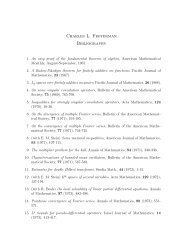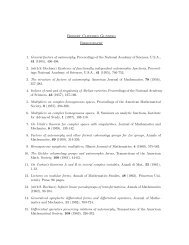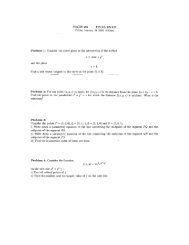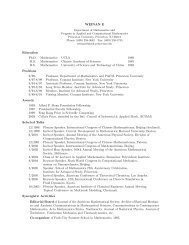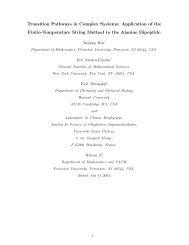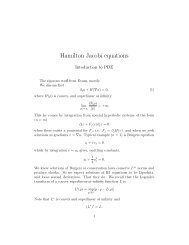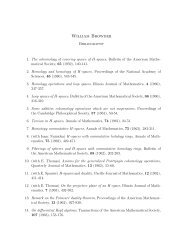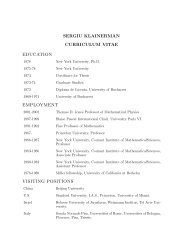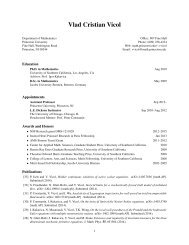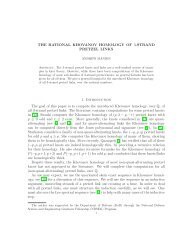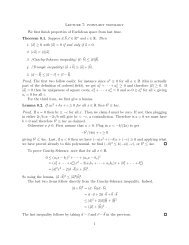A generalization of the asymptotic formula in Waring's problem with ...
A generalization of the asymptotic formula in Waring's problem with ...
A generalization of the asymptotic formula in Waring's problem with ...
You also want an ePaper? Increase the reach of your titles
YUMPU automatically turns print PDFs into web optimized ePapers that Google loves.
THE VINOGRADOV l 2 MAXIMAL THEOREM FOR HIGHER ORDER<br />
SPHERES<br />
K HUGHES<br />
Contents<br />
1. Introduction 1<br />
2. The ma<strong>in</strong> l p <strong>in</strong>equality 2<br />
3. Aprroximat<strong>in</strong>g by <strong>the</strong> Hardy-Littlewood multiplier HL 2<br />
3.1. The major arcs 4<br />
3.2. The m<strong>in</strong>or arcs 6<br />
4. The Hardy-Littlewood multiplier 7<br />
5. Extend<strong>in</strong>g <strong>the</strong> result to p < 2 8<br />
6. Cont<strong>in</strong>uous analogue: Convex hypersurfaces: Fourier tranforms and averages 8<br />
References 9<br />
1. Introduction<br />
Throughout fix k ≥ 2 an <strong>in</strong>teger. Def<strong>in</strong>e <strong>the</strong> ”k-sphere” norm |x| k for x ∈ R d to be ∑ d<br />
i=1 |x i| k<br />
and <strong>the</strong> <strong>in</strong>dicator function <strong>of</strong> <strong>the</strong> discrete k-sphere to be σ r = 1 {x∈Z d :|x| k =r k } <strong>of</strong> radius r which<br />
conta<strong>in</strong>s N d,k (r) lattice po<strong>in</strong>ts. The dimension d will always be greater than k.<br />
A r f = 1<br />
N(r) σ r ∗ |f|<br />
A R f = A r f<br />
sup<br />
R/2≤r0<br />
Remark 1.1. The supremum above is taken over all positive r such that N(r) ≠ 0 e.g. only k-spheres<br />
<strong>with</strong> lattice po<strong>in</strong>ts on <strong>the</strong>m. For large enough dimension, this is equivalent to r k ∈ N.<br />
Us<strong>in</strong>g V<strong>in</strong>ogradov type estimates and <strong>the</strong> methods <strong>of</strong> Magyar([6]) and Magyar–Ste<strong>in</strong>–Wa<strong>in</strong>ger<br />
aka MSW ([8]), I show<br />
Theorem 1. For k ≥ 3, A ∗ is a bound operator on l 2 (Z d ) provided d > 11k 3 log k.<br />
Interpolat<strong>in</strong>g <strong>with</strong> a trivial l 1 bound for <strong>the</strong> dyadic maximal operator (see [6]), I can improve<br />
<strong>the</strong> range <strong>of</strong> l p spaces to<br />
Theorem 2. For k ≥ 3, A ∗ is a bound operator on l p (Z d ) for p > 1 +<br />
d > 11k 3 log k.<br />
In [8], MSW studied this <strong>problem</strong> when k = 2 prov<strong>in</strong>g <strong>the</strong> sharp result:<br />
11k3 log k<br />
2d−11k 3 log k<br />
Magyar–Ste<strong>in</strong>–Wa<strong>in</strong>ger. For k = 2 and d ≥ 5, ‖A ∗ f‖ l p ‖f‖ l p for all p > d<br />
d−2 .<br />
1<br />
provided
Subsequently, <strong>in</strong> [7], Magyar extended <strong>the</strong> MSW result to averages over nondegenerate positive<br />
<strong>in</strong>tegral forms prov<strong>in</strong>g <strong>the</strong> same result <strong>with</strong> d > k2 k−1 . This <strong>in</strong>cludes <strong>the</strong> family <strong>of</strong> hypersurfaces<br />
considered here. This note improves <strong>the</strong> dimension from exponential to polynomial by us<strong>in</strong>g V<strong>in</strong>ogradov<br />
type bounds for exponential sums. The pro<strong>of</strong> relies on a Hardy-Littlewood decomposition<br />
as <strong>in</strong> [6, 8] to approximate <strong>the</strong> multiplier <strong>of</strong> <strong>the</strong> convolution operator <strong>in</strong> <strong>the</strong> l 2 norm and show<strong>in</strong>g<br />
that both <strong>the</strong> approximant and approximation are l 2 bounded. We note that <strong>in</strong> <strong>the</strong> context <strong>of</strong> <strong>the</strong><br />
circle method, Magyar–Ste<strong>in</strong>–Wa<strong>in</strong>ger corresponds to <strong>the</strong> sums <strong>of</strong> squares <strong>in</strong> War<strong>in</strong>g’s <strong>problem</strong>,<br />
while this note corresponds to <strong>the</strong> sums <strong>of</strong> k th powers <strong>in</strong> War<strong>in</strong>g’s <strong>problem</strong>.<br />
Remark 1.2. Test<strong>in</strong>g <strong>the</strong> maximal operator on <strong>the</strong> delta function, we expect that <strong>the</strong> maximal<br />
operator is bounded on l p for p ><br />
d<br />
d−k<br />
as <strong>in</strong> MSW. However, <strong>the</strong> range I obta<strong>in</strong> is far away from<br />
this and to improve it us<strong>in</strong>g <strong>the</strong> method <strong>in</strong> this paper, I would need to improve V<strong>in</strong>ogradov estimates<br />
for exponential sums which is a difficult, open <strong>problem</strong> <strong>in</strong> number <strong>the</strong>ory. You might th<strong>in</strong>k that<br />
one could improve <strong>the</strong> l 1 <strong>in</strong>equality, but if I could, <strong>the</strong>n I could probably do this <strong>in</strong> 2 dimensions<br />
and this would give me a better range <strong>of</strong> l p spaces than is possible.<br />
2. The ma<strong>in</strong> l p <strong>in</strong>equality<br />
We will make use <strong>of</strong> <strong>the</strong> follow<strong>in</strong>g <strong>in</strong>equality below. If T r is a convolution operator <strong>with</strong> multiplier<br />
m r (ξ) = ∫ I α R(t, ξ)e(−r k t) dt for some measurable subset <strong>of</strong> <strong>the</strong> torus. Then<br />
∫<br />
sup |T r f|(x) =<br />
∣ α R (t, ξ)e(−r<br />
R/2≤r
where N k (r) = #{y : |y| k = r k }. For sufficiently large d, we know that N(r) ∼ d,k r d−k . So we may<br />
replace <strong>the</strong> averages A r <strong>with</strong><br />
∑<br />
r d−k f(x − y)<br />
|y| k =r k<br />
also denoted by A r . Now A r is a convolution operator <strong>with</strong> multiplier r k−d a r (ξ) where<br />
a r (ξ) =<br />
∑<br />
e(x · ξ)<br />
|x| k =r k<br />
And s<strong>in</strong>ce ∫ T<br />
e(t(x − y))dt is 1 or 0 depend<strong>in</strong>g on whe<strong>the</strong>r x = y or not, we can rewrite this as<br />
a r (ξ) = ∑ ∫<br />
e((|x| k − r k )t + x · ξ) dt<br />
x∈Z d<br />
and fur<strong>the</strong>rmore we can dampen <strong>the</strong> sum by <strong>in</strong>sert<strong>in</strong>g factors <strong>of</strong> e −2πɛ|x|k to get<br />
a r (ξ) = e ∑ ∫<br />
2πɛrk e(|x| k (t + iɛ) − tr k + xξ) dt<br />
x∈Z d<br />
T<br />
T<br />
Let H z (ξ) = ∑ x∈Z d e(|x|k z + xξ), <strong>the</strong>n exchang<strong>in</strong>g <strong>the</strong> sum and <strong>in</strong>tegral above (which is possible<br />
by <strong>the</strong> dampen<strong>in</strong>g) a r (ξ) = e<br />
∫T 2πɛrk e(−trk )H t+iɛ (ξ) dt. For a level R k−1 > 0, make a Farey<br />
dissection on T (which I identify <strong>with</strong> [0, 1] via <strong>the</strong> exponential map e(·)) <strong>of</strong> level R k−1 . This<br />
yields a sequence <strong>of</strong> <strong>in</strong>tervals Ī(a/q) = {θ ∈ [0, 1] : −β/qRk−1 ≤ θ − a/q ≤ α/qR k−1 } where<br />
α(a/q, R k−1 ), β(a/q, R k−1 ) ≈ 1. I(a/q) = Ī(a/q) − a/q. Decompose a r <strong>with</strong> respect to this dissection:<br />
a r (ξ) =<br />
∑ ∑<br />
a a/q<br />
r (ξ)<br />
q≤R k−1 (a,q)=1<br />
<strong>with</strong><br />
∫<br />
a a/q<br />
r (ξ) = e 2πɛrk e(r k a/q) e(−tr k )H z (t − a/q + iɛ, ξ) dt<br />
I(a/q)<br />
For a parameter Y which we optimize below, split our multiplier <strong>in</strong>to pieces from major arcs<br />
and pieces from m<strong>in</strong>or arcs<br />
a Major<br />
r<br />
a m<strong>in</strong>or<br />
r (ξ) =<br />
(ξ) = ∑ q
Basic Weyl sum bound. For all a ∈ Z/qZ ∗ , x ∈ Z,<br />
1<br />
q∑<br />
e(b k a/q + bx/q) q −1/k .<br />
q<br />
n=1<br />
Remark 3.1. One can actually improve this us<strong>in</strong>g an <strong>in</strong>equality <strong>of</strong> Hua to ≪ δ q δ− 1 2 for all δ > 0.<br />
If we let,<br />
∫<br />
J r (ξ − x/q) = ˜h z (x/q − ξ)e(−r k t) dt,<br />
<strong>the</strong>n we can write<br />
I(a/q)<br />
a a/q<br />
r (ξ) = e 2πɛrk e(r k a/q) ∑ x<br />
G(a/q, x)J r (ξ − x/q).<br />
Remark 3.2. We will always choose ɛ = R −k so that <strong>the</strong> factor e 2πɛrk ≪ 1.<br />
3.1. The major arcs. Introduce <strong>the</strong> approximat<strong>in</strong>g multipliers b a/q<br />
r , c a/q<br />
r def<strong>in</strong>ed as follows:<br />
b a/q<br />
r (ξ) = e 2πɛrk e(r k a/q) ∑ x<br />
G(a/q, x)Ψ(qξ − x)J r (ξ − x/q)<br />
c a/q<br />
r (ξ) = e 2πɛrk e(r k a/q) ∑ x<br />
G(a/q, x)Ψ(qξ − x)I r (ξ − x/q)<br />
where I r = ∫ ˜h R z (x/q − ξ) is obta<strong>in</strong>ed from J r by extend<strong>in</strong>g <strong>the</strong> range <strong>of</strong> <strong>in</strong>tegration from I(a/q)<br />
to R. Us<strong>in</strong>g <strong>the</strong>se we def<strong>in</strong>e multipliers b r , c r <strong>with</strong> convolution operators Br<br />
Major , Cr<br />
Major by<br />
b Major<br />
r (ξ) = ∑ ∑<br />
b a/q<br />
r (ξ)<br />
q 0<br />
such that for all f ∈ l 2 and R > 0,<br />
∥<br />
sup |A Major<br />
r f − Cr Major<br />
f| ∥ R d−k−θ ‖f‖ l 2<br />
R/2≤r
(2) ˜h z (ξ − x/q) ≪ |z| − d<br />
2k−2 |ξ − l/q|<br />
−d k−2<br />
2k−2 e<br />
−K·|qξ−l| k−1<br />
for some constant K = K d,k depend<strong>in</strong>g<br />
only on dimension and degree.<br />
∥<br />
Lemma 3.2. ∥sup R/2≤r 1/2. Then we have<br />
∑<br />
G(a, q, x)(1 − Ψ(qξ − x))˜h z (ξ − x/q) =<br />
x<br />
∑<br />
|qξ−x|>1/2<br />
≪ sup<br />
x<br />
≪ sup<br />
x<br />
≪ sup<br />
x<br />
≪ sup<br />
x<br />
k<br />
G(a, q, x)(1 − Ψ(qξ − x))˜h z (ξ − x/q)<br />
|G(a, q, x)|<br />
|G(a, q, x)|<br />
∑<br />
|qξ−x|>1/2<br />
∑<br />
|qξ−x|>1/2<br />
|G(a, q, x)| · |z| −<br />
|G(a, q, x)| · |z| −<br />
|˜h z (ξ − x/q)|<br />
|z| − d<br />
2k−2 |ξ − l/q|<br />
−d k−2<br />
d d(k−2)<br />
2k−2 q 2k−2<br />
d d(k−2)<br />
2k−2 q 2k−2<br />
≪ sup |G(a, q, x)| · (qR k−1 ) d d(k−2)<br />
2k−2 q 2k−2<br />
x<br />
= sup |G(a, q, x)| · R d/2 q d/2<br />
x<br />
≪ R d/2 q d/2−d/k<br />
∑<br />
|qξ−x|>1/2<br />
k<br />
2k−2 e<br />
−K·|qξ−l| k−1<br />
k−2<br />
−d<br />
|qξ − l|<br />
Summ<strong>in</strong>g over a ∈ Z/qZ ∗ and 1 ≤ q ≤ R, we get a bound <strong>of</strong> ≪ R d+2−d/k ). We need power<br />
sav<strong>in</strong>g <strong>in</strong> R, so we choose d > k(k + 2).<br />
∥<br />
Lemma 3.3. ∥sup R/2≤r
We sum over a and q to f<strong>in</strong>d<br />
R∑ ∑<br />
∥<br />
Choose d > k(k + 2).<br />
q=1 (a,q)=1<br />
sup<br />
R/2≤r
Choos<strong>in</strong>g d such that<br />
d<br />
11k 2 log k > k or more simply, d > 11k3 log k, we get<br />
Corollary 3.1. For d > 11k 3 log k, <strong>the</strong>re exists a θ(k, d) > 0 such that for all f ∈ l 2 and R > 0,<br />
∥<br />
sup |A m<strong>in</strong>or<br />
r f| ∥ ≪ R d−k−θ ‖f‖ l 2<br />
R/2≤r0<br />
Lemma 4.1. ‖C ∗ f‖ l 2 ‖f‖ l 2 where <strong>the</strong> implied constant depends only on <strong>the</strong> degree k and <strong>the</strong><br />
dimension d.<br />
Pro<strong>of</strong>. Recall that<br />
Ĉ r f(ξ) =<br />
∞∑<br />
By <strong>the</strong> triangle <strong>in</strong>equality, we have<br />
To prove this, we will show that<br />
Then<br />
∑<br />
∑<br />
q=1 a∈Z/qZ ∗<br />
‖C ∗ f‖ l 2 ≤<br />
∥<br />
If d > 2k, <strong>the</strong>n <strong>the</strong> sum converges and<br />
∥C∗<br />
a/q<br />
C a/q<br />
r<br />
to<br />
x∈Z d G(a, q, x)Ψ(qξ − x)˜dσ r (ξ − x/q)<br />
∞∑ ∑ ∥ ∥∥C a/q ∥<br />
∗ f<br />
a∈Z/qZ ∗<br />
q=1<br />
f∥ q−d/k ‖f‖<br />
l 2 l 2 .<br />
∥<br />
l 2<br />
∑<br />
∞ ∑<br />
‖C ∗ f‖ l 2 k,d<br />
q −d/k ‖f‖ l 2<br />
q=1 a∈Z/qZ ∗<br />
∞∑<br />
δ,d,k ‖f‖ l 2 q −d/k+1 .<br />
q=1<br />
‖C ∗ f‖ l 2 k,d ‖f‖ l 2 .<br />
To prove <strong>the</strong> aforementioned <strong>in</strong>equality, we first separate our study <strong>of</strong> Cr<br />
a/q f <strong>in</strong>to a f<strong>in</strong>ite part<br />
and a cont<strong>in</strong>uous part by writ<strong>in</strong>g<br />
̂<br />
C a/q (ξ) = ∑ G(a, q, x)Ψ(qξ − x)Ψ 1 (qξ − x)dσ r (ξ − x/q)<br />
x∈Z d<br />
r<br />
⎛<br />
⎞ ⎛<br />
= ⎝ ∑ G(a, q, x)Ψ(qξ − x) ⎠ ⎝ ∑ Ψ 1 (qξ − x)d˜σ r (ξ − x/q) ⎠<br />
x∈Z d x∈Z d<br />
⎞
and n a/q<br />
r <strong>with</strong><br />
convolution operators Sr<br />
a/q and Tr<br />
a/q respectively, so that Cr<br />
a/q f = Sr<br />
a/q Tr<br />
a/q f = Tr<br />
a/q Sr<br />
a/q f (note<br />
that S implicitly depends on r, but when we bound it later, we can bound it <strong>in</strong>dependently <strong>of</strong> r).<br />
This means that we only need to show that each maximal operator is bounded on l 2 for arbitrary<br />
functions; <strong>the</strong> norm would be bounded by <strong>the</strong> product <strong>of</strong> <strong>the</strong>se norms. T∗<br />
a/q is bounded us<strong>in</strong>g a<br />
vector-valued version <strong>of</strong> a <strong>the</strong>orem <strong>of</strong> Bruna–Nagel–Wa<strong>in</strong>ger (see below) while S∗<br />
a/q is bounded by<br />
For each r, our multiplier is <strong>the</strong> product <strong>of</strong> two commut<strong>in</strong>g multipliers, say m a/q<br />
r<br />
us<strong>in</strong>g Plancherel’s <strong>the</strong>orem (<strong>in</strong>clude Ste<strong>in</strong>-Wa<strong>in</strong>ger folk lemma later). Given <strong>the</strong> support <strong>of</strong> Ψ and<br />
known bounds for Weyl sums, we can bound <strong>the</strong> first part by ≪ q −d/k .<br />
□<br />
Remark 4.1. Comb<strong>in</strong><strong>in</strong>g <strong>the</strong> Basic Weyl sum bound <strong>with</strong> <strong>the</strong> Ste<strong>in</strong>–Wa<strong>in</strong>ger folk lemma we can<br />
actually say more (at least about <strong>the</strong> arithmetic part): <strong>the</strong> Hardy–Littlewood multiplier is bounded<br />
on l p for p ><br />
d<br />
d−k . 5. Extend<strong>in</strong>g <strong>the</strong> result to p < 2<br />
By <strong>the</strong> previous section we already know that <strong>the</strong> Hardy–Littlewood multiplier is bounded on<br />
l p for p ><br />
d<br />
d−k<br />
, so we want to understand <strong>the</strong> range <strong>of</strong> p for which <strong>the</strong> error terms are bounded<br />
on l p . The methods above are special l 2 , so we’ll comb<strong>in</strong>e <strong>the</strong>se by <strong>in</strong>terpolation <strong>with</strong> a trivial l 1<br />
bound. The trivial l 1 bound for <strong>the</strong> dyadic maximal operator is R k . The l 2 bound is R −θ for some<br />
θ depend<strong>in</strong>g on k and d. S<strong>in</strong>ce k is fixed, we see that θ → ∞ as d → ∞ so that <strong>the</strong> error terms are<br />
bounded <strong>in</strong> l p for p > p 0 (d) where p 0 (d) → 1 while d → ∞.<br />
More precisely, <strong>in</strong>terpolation tells us that <strong>the</strong> bound for <strong>the</strong> dyadic maximal operator will be<br />
R −ɛ(p) for some positive ɛ(p) when p > 2(θ+k)<br />
2θ+k = 1 + k<br />
2θ+k<br />
. Exam<strong>in</strong><strong>in</strong>g <strong>the</strong> pro<strong>of</strong> we see that <strong>the</strong><br />
θ we can choose for <strong>the</strong> error terms <strong>in</strong> study<strong>in</strong>g <strong>the</strong> major arcs is d k<br />
− 2 − k while <strong>the</strong> θ we can<br />
choose for <strong>the</strong> error terms <strong>in</strong> study<strong>in</strong>g <strong>the</strong> m<strong>in</strong>or arcs is − k. We must use <strong>the</strong> smallest<br />
which is θ(k, d) =<br />
p > 1 +<br />
d<br />
d<br />
11k 2 log k<br />
11k 2 log k − k for d > 11k3 log k. Plugg<strong>in</strong>g this <strong>in</strong>to our bound above, we get<br />
k<br />
−k+2d/(11k 2 log k) = 1 + 11k3 log k<br />
2d−11k 3 log k for d > 11k3 log k.<br />
6. Cont<strong>in</strong>uous analogue: Convex hypersurfaces: Fourier tranforms and averages<br />
Let S be a smooth, compact, convex hypersurface <strong>in</strong> R d+1 for d > 1 <strong>of</strong> f<strong>in</strong>ite type and σ its<br />
<strong>in</strong>duced Lebesgue surface measure (a will be arbitrary but all implicit constants may depend on<br />
it). Fur<strong>the</strong>rmore, let dσ 0 (x) = a(x)dσ(x) where a is a smooth, compactly supported function <strong>in</strong> a<br />
neighborhood <strong>of</strong> x 0 ∈ S. For x ∈ S, denote <strong>the</strong> outward unit normal to S at x by v x and if T x is<br />
<strong>the</strong> tangent plane at x, <strong>the</strong>n for δ > 0, def<strong>in</strong>e <strong>the</strong> δ-ball about x as<br />
Def<strong>in</strong>e <strong>the</strong> averages<br />
and <strong>the</strong> associated maximal function<br />
Bruna–Nagel–Wa<strong>in</strong>ger. As t → ∞,<br />
B(x, δ) = {y ∈ S : dist(y, T x ) < δ}.<br />
∫<br />
A t f(x) =<br />
S<br />
f(x − ty)dσ 0 (y)<br />
Mf(x) = sup |A t f(x)|.<br />
t>0<br />
̂dσ(tv x ) σ(B(x, t −1 ))<br />
Interpolation. If ̂dσ(ξ) |ξ| −γ for large ξ and some γ > 1/2, <strong>the</strong>n M is a bounded operator on<br />
L p for p > 1 + (2γ) −1
Def<strong>in</strong>e <strong>the</strong> norm |x| k = ∑ d+1<br />
i=1 |x i| k and <strong>the</strong> d-dimensional hypersurface S d k := {x : |x|k = 1}. S d k<br />
is f<strong>in</strong>ite type <strong>of</strong> order k and for <strong>the</strong> poles x = (0, . . . , 0, ±1), etc., we have<br />
σ(B(x, δ)) δ d/k .<br />
Consider<strong>in</strong>g a smooth partition <strong>of</strong> unity on <strong>the</strong> hypersurface and <strong>the</strong> above <strong>the</strong>orem, we obta<strong>in</strong><br />
Corollary 6.1. For d > 2k, M is a bounded operator on L p for p > 1 + (2d/k) −1 = 2d+k<br />
2d .<br />
Remark 6.1. I need to check this because it does not match <strong>with</strong> <strong>the</strong> spherical case<br />
2d−2 =<br />
This would give p > d+1<br />
d<br />
d<br />
, but this exponent is <<br />
d−1<br />
which is <strong>the</strong> right exponent for <strong>the</strong> sphere.<br />
Remark 6.2. While <strong>the</strong>se reults may not be sharp <strong>in</strong> <strong>the</strong> cont<strong>in</strong>uous sett<strong>in</strong>g, this is sufficient for<br />
our purposes.<br />
References<br />
[1] M. Avdispahic and L. Smajlovic, On maximal operators on k-spheres <strong>in</strong> Z n Proceed<strong>in</strong>gs <strong>of</strong> <strong>the</strong> American Ma<strong>the</strong>matical<br />
Society, Vol. 134, No. 7, Pages 2125-2130, 2006.<br />
[2] Bruna, Nagel and Wa<strong>in</strong>ger Someth<strong>in</strong>g about convex hypersurfaces .<br />
[3] H. Davenport, Analytic methods for Diophant<strong>in</strong>e equations and <strong>in</strong>equalities Cambridge University Press, 2nd ed.,<br />
2005;<br />
[4] G. Hardy and J. Littlewood, Some <strong>problem</strong>s <strong>of</strong> ’Partitio Numerorum 1: A new solution <strong>of</strong> War<strong>in</strong>g’s <strong>problem</strong><br />
Hardy’s Collected works, .<br />
[5] H. Iwaniec and E. Kowalski, Analytic number <strong>the</strong>ory American Ma<strong>the</strong>matical Society, Colloquium Publications,<br />
V. 53, 2004.<br />
[6] A. Magyar, L p bounds for spherical maximal operators on Z n Revista Matematica Iberoamericana, Vol. 13, No.<br />
2, 1997;<br />
[7] A. Magyar, Diophant<strong>in</strong>e equations and ergodic <strong>the</strong>orems Revista Matematica Iberoamericana, Vol. 13, No. 2,<br />
1997;<br />
[8] A. Magyar, E. Ste<strong>in</strong> and S. Wa<strong>in</strong>ger Discrete analogues <strong>in</strong> harmonic analysis: Spherical averages Annals <strong>of</strong><br />
Ma<strong>the</strong>matics, 2005;<br />
[9] H. Montgomery, 10 Lectures on <strong>the</strong> <strong>in</strong>terface between analytic number <strong>the</strong>ory and harmonic analysis Conference<br />
Board <strong>of</strong> <strong>the</strong> Ma<strong>the</strong>matical Sciences, Regional Conference Series <strong>in</strong> Ma<strong>the</strong>matics, Number 84, 1994.<br />
2d<br />
d<br />
d−1 .




